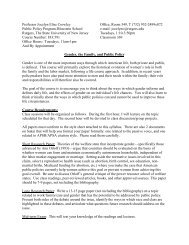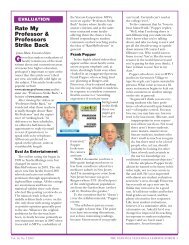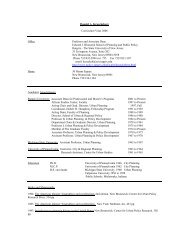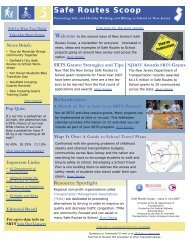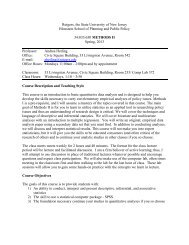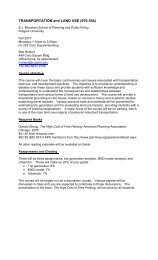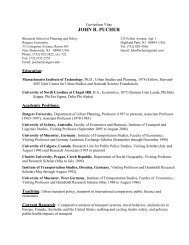Public transport in Seoul - Bloustein School of Planning and Public ...
Public transport in Seoul - Bloustein School of Planning and Public ...
Public transport in Seoul - Bloustein School of Planning and Public ...
Create successful ePaper yourself
Turn your PDF publications into a flip-book with our unique Google optimized e-Paper software.
REGIONAL FOCUS<br />
Red <strong>and</strong> blue express<br />
buses us<strong>in</strong>g median<br />
bus lanes <strong>in</strong><br />
<strong>Seoul</strong>, protected from<br />
heavy traffic congestion<br />
on regular lanes<br />
Photo: <strong>Seoul</strong> Metropolitan Government<br />
<strong>Public</strong> <strong>transport</strong> <strong>in</strong> <strong>Seoul</strong><br />
Meet<strong>in</strong>g the burgeon<strong>in</strong>g travel dem<strong>and</strong>s<br />
<strong>of</strong> a megacity<br />
Pr<strong>of</strong>. John Pucher, Ph.D., Hyungyong Park, MCP, Ph.D. c<strong>and</strong>idate, <strong>and</strong> Mook Han Kim, MCP, Ph.D. c<strong>and</strong>idate, Rutgers University,<br />
New Jersey <strong>and</strong> Jum<strong>in</strong> Song, MCRP, Ph.D. c<strong>and</strong>idate, University <strong>of</strong> Michigan, USA<br />
With over 22 million residents, the Greater <strong>Seoul</strong> metropolitan area depends crucially<br />
on public <strong>transport</strong> for its grow<strong>in</strong>g travel needs. Rail <strong>and</strong> bus services carry 65% <strong>of</strong> all<br />
trips <strong>in</strong> <strong>Seoul</strong>, one <strong>of</strong> the world’s highest market shares <strong>of</strong> public <strong>transport</strong>.<br />
54 <strong>Public</strong> Transport International - 3/2005<br />
Introduction<br />
South Korea has been one <strong>of</strong> the<br />
fastest grow<strong>in</strong>g countries <strong>in</strong> the<br />
Pacific Rim area. <strong>Seoul</strong>, the capital<br />
city has been one <strong>of</strong> the<br />
world’s fastest grow<strong>in</strong>g megacities,<br />
quadrupl<strong>in</strong>g <strong>in</strong> population<br />
between 1960 <strong>and</strong> 2002. The<br />
Greater <strong>Seoul</strong> metropolitan area<br />
now covers 12,446 km2 <strong>and</strong> has<br />
22.5 million <strong>in</strong>habitants. It<br />
<strong>in</strong>cludes the City <strong>of</strong> <strong>Seoul</strong> itself<br />
as well as the City <strong>of</strong> Incheon <strong>and</strong><br />
Gyeonggi Prov<strong>in</strong>ce.<br />
With a population <strong>of</strong> 9.9 million<br />
<strong>in</strong> 2003, the core City <strong>of</strong> <strong>Seoul</strong> is<br />
one <strong>of</strong> the world’s largest cities,<br />
<strong>and</strong> with 16,500 <strong>in</strong>habitants per<br />
km2 , also one <strong>of</strong> the world’s<br />
most densely populated cities;<br />
1.3 times denser than Tokyo <strong>and</strong><br />
twice as dense as New York.<br />
Scarcity <strong>of</strong> l<strong>and</strong>, overcrowd<strong>in</strong>g,<br />
high hous<strong>in</strong>g prices, <strong>and</strong> serious<br />
traffic congestion have forced<br />
the decentralisation <strong>of</strong> most new<br />
hous<strong>in</strong>g to the surround<strong>in</strong>g suburbs,<br />
which now conta<strong>in</strong> more<br />
than 12 million residents <strong>and</strong><br />
cont<strong>in</strong>ue to grow rapidly.<br />
Population growth <strong>and</strong> the vast<br />
expansion <strong>of</strong> the geographic area<br />
<strong>of</strong> Greater Metropolitan <strong>Seoul</strong><br />
have contributed to rapid growth<br />
<strong>in</strong> travel dem<strong>and</strong>. Both the number<br />
<strong>of</strong> daily trips per person <strong>and</strong><br />
their average length have been<br />
steadily <strong>in</strong>creas<strong>in</strong>g, especially for<br />
residents <strong>in</strong> the outer portions <strong>of</strong><br />
the metropolitan area. More <strong>and</strong><br />
more workers live <strong>in</strong> the distant<br />
suburbs, <strong>in</strong>clud<strong>in</strong>g five large new<br />
towns (planned ‘satellite cities’),<br />
but must commute to jobs that<br />
are still concentrated <strong>in</strong> the central<br />
city <strong>of</strong> <strong>Seoul</strong>. An <strong>in</strong>creas<strong>in</strong>g<br />
percentage <strong>of</strong> firms are also<br />
decentralis<strong>in</strong>g to the suburbs, but<br />
suburb-to-suburb commutes to<br />
suburban jobs can also be quite<br />
long because the overall <strong>transport</strong><br />
system is radially focused on<br />
the centre <strong>and</strong> not designed to<br />
connect up the suburbs.<br />
Increased per-capita <strong>in</strong>come<br />
<strong>and</strong> car ownership have also<br />
spurred growth <strong>in</strong> travel. S<strong>in</strong>ce<br />
1970, real per capita <strong>in</strong>come <strong>in</strong><br />
South Korea has risen dramatically<br />
(see Figure 1). Expressed<br />
<strong>in</strong> constant, <strong>in</strong>flation-adjusted<br />
2004 US dollars, per-capita<br />
<strong>in</strong>come rose from only USD 311<br />
<strong>in</strong> 1970 to USD 2,044 <strong>in</strong> 1980,<br />
USD 7,378 <strong>in</strong> 1990, <strong>and</strong> USD<br />
12,531 <strong>in</strong> 2002. That represents<br />
a 40-fold <strong>in</strong>crease <strong>in</strong> real per<br />
capita <strong>in</strong>come <strong>in</strong> only 32 years,<br />
a truly astound<strong>in</strong>g accomplishment<br />
for any country.<br />
Private car ownership has<br />
<strong>in</strong>creased at almost the same<br />
pace as per-capita <strong>in</strong>come.<br />
While only a t<strong>in</strong>y percentage <strong>of</strong><br />
Koreans owned cars <strong>in</strong> 1970 (2<br />
cars per 1,000 persons!), the<br />
rate <strong>of</strong> car ownership rose to<br />
215 per 1,000 persons by 2003.<br />
Car ownership <strong>in</strong> the City <strong>of</strong><br />
<strong>Seoul</strong> (214) is almost identical<br />
to the national average, but it is<br />
higher for Gyeonggi Prov<strong>in</strong>ce<br />
(237), which consists <strong>of</strong> more<br />
car-oriented, lower-density suburbs.<br />
Increased use <strong>of</strong> private<br />
cars has caused serious traffic<br />
congestion, especially on the<br />
radial arterial highways connect<strong>in</strong>g<br />
the suburbs to the central<br />
city. Average roadway<br />
speeds are only 20km per hour<br />
overall, <strong>and</strong> only 17km per hour<br />
<strong>in</strong> the city’s two central bus<strong>in</strong>ess<br />
districts. Congestion<br />
costs are estimated to exceed<br />
USD 8 billion a year, about 4%<br />
<strong>of</strong> GDP. Increased car use has<br />
also caused dangerously high<br />
levels <strong>of</strong> air pollution, noise,<br />
<strong>and</strong> traffic accidents as well as<br />
excessive use <strong>of</strong> scarce l<strong>and</strong> for<br />
roadways <strong>and</strong> park<strong>in</strong>g facilities.<br />
Overall travel trends<br />
Perhaps the most strik<strong>in</strong>g trend<br />
<strong>in</strong> travel is the large <strong>in</strong>crease <strong>in</strong><br />
total trips made. Data for the<br />
suburbs are not available, but<br />
for the central City <strong>of</strong> <strong>Seoul</strong>, the<br />
total number <strong>of</strong> daily trips rose<br />
5-fold between 1970 <strong>and</strong> 2002,<br />
from 5.7 million to 29.6 million.<br />
Cont<strong>in</strong>ued economic growth <strong>in</strong><br />
the com<strong>in</strong>g years virtually<br />
ensures cont<strong>in</strong>ued growth <strong>in</strong><br />
travel dem<strong>and</strong> <strong>in</strong> the future. That<br />
growth <strong>in</strong> travel is likely to be<br />
greatest <strong>in</strong> the suburbs, where<br />
both population <strong>and</strong> <strong>in</strong>come are<br />
projected to rise significantly.<br />
Cars per 1,000 population<br />
The large <strong>in</strong>crease <strong>in</strong> car ownership<br />
<strong>and</strong> use <strong>in</strong> the 1980s <strong>and</strong><br />
early 1990s dim<strong>in</strong>ished public<br />
<strong>transport</strong>’s share <strong>of</strong> total travel<br />
<strong>in</strong> <strong>Seoul</strong>. Thus, the comb<strong>in</strong>ed<br />
modal share <strong>of</strong> bus <strong>and</strong> metro<br />
fell from 75% <strong>in</strong> 1980 to a low <strong>of</strong><br />
60% <strong>in</strong> 1996 (see Figure 2). By<br />
comparison, trips by private car<br />
rose from only 4% <strong>in</strong> 1980 to<br />
21% over the same period. 1996<br />
was a turn<strong>in</strong>g po<strong>in</strong>t. Thanks to a<br />
comb<strong>in</strong>ation <strong>of</strong> metro system<br />
expansion <strong>and</strong> car-restrictive<br />
policies implemented <strong>in</strong> the mid-<br />
1990s, public <strong>transport</strong>’s share<br />
<strong>of</strong> trips rose from 60% <strong>in</strong> 1996 to<br />
65% <strong>in</strong> 2002, while the car’s<br />
share fell from 21% to 18%.<br />
Those successful policies will be<br />
exam<strong>in</strong>ed later <strong>in</strong> this article.<br />
REGIONAL FOCUS<br />
250 16000<br />
200<br />
150<br />
100<br />
70<br />
60<br />
50<br />
40<br />
30<br />
20<br />
10<br />
0<br />
FIGURE 1: INCREASES IN CAR OWNERSHIP PARALLELING GROWTH IN REAL PER-CAPITA INCOME IN<br />
SOUTH KOREA, 1970-2002 (IN CONSTANT, INFLATION-ADJUSTED 2004 US DOLLARS)<br />
50<br />
0<br />
1970 1975 1980 1985 1990 1995 2000<br />
Sources: Korea Transport Database <strong>and</strong> Korea National Statistical Office<br />
Percentage <strong>of</strong> total trips<br />
198O 1985 1990 1992 1995 1996 1997 1998 1999 2000 2001 2002<br />
Year<br />
Cars per 1000 population Real <strong>in</strong>come (GDP) per capita<br />
FIGURE 2: TRENDS IN MODAL SHARES OF TOTAL TRIPS IN SEOUL, 1980-2002<br />
(PERCENT OF TRIPS BY EACH TYPE OF TRANSPORT)<br />
Metro<br />
Bus<br />
Sources: <strong>Seoul</strong> Metropolitan Government <strong>and</strong> <strong>Seoul</strong> Development Institute<br />
Year<br />
Car<br />
Taxis<br />
Another important trend for public<br />
<strong>transport</strong> is the simultaneous<br />
drop <strong>in</strong> bus usage <strong>and</strong> rise <strong>in</strong><br />
metro use (see Figure 3). Indeed,<br />
the annual number <strong>of</strong> bus passengers<br />
has fallen almost cont<strong>in</strong>uously<br />
over the past two<br />
decades, from 2,582 million <strong>in</strong><br />
1980 to only 1,526 million <strong>in</strong><br />
2002. In contrast, urban rail passengers<br />
rose steadily with each<br />
successive expansion <strong>of</strong> the<br />
metro system, from 198 million<br />
<strong>in</strong> 1980 to 2,231 million <strong>in</strong> 2002.<br />
Urban <strong>and</strong> suburban rail<br />
systems<br />
The <strong>Seoul</strong> Metropolitan Government<br />
has focused on improvements<br />
to <strong>Seoul</strong>’s metro system<br />
as the key strategy to deal with<br />
<strong>Public</strong> Transport International - 3/2005<br />
14000<br />
12000<br />
10000<br />
8000<br />
6000<br />
4000<br />
2000<br />
0<br />
Real <strong>in</strong>come (GDP) per capita, <strong>in</strong><br />
constant 2004 US dollars<br />
55
REGIONAL FOCUS<br />
Passengers (millions)<br />
3000<br />
2500<br />
2000<br />
1500<br />
1000<br />
500<br />
FIGURE 3: TRENDS IN BUS, METRO, AND TAXI PASSENGERS IN SEOUL,<br />
1980-2002 (MILLIONS OF PASSENGER TRIPS)<br />
0<br />
198O 1982 1984 1986 1988 1990 1992 1994 1996 1998 2000 2002<br />
Metro<br />
Metro<br />
56 <strong>Public</strong> Transport International - 3/2005<br />
Bus<br />
Taxis Bus<br />
Sources: M<strong>in</strong>istry <strong>of</strong> Construction <strong>and</strong> Transportation <strong>and</strong> Korea Transportation Database<br />
Taxi<br />
the city’s many <strong>transport</strong>-related<br />
problems. Until 1974, <strong>Seoul</strong><br />
was almost entirely dependent<br />
on bus services. Sharply ris<strong>in</strong>g<br />
roadway congestion, reduced<br />
bus speeds, <strong>in</strong>creased passenger<br />
volumes, <strong>and</strong> longer trip<br />
distances <strong>in</strong>creased the necessity<br />
for an urban rail system.<br />
The first metro l<strong>in</strong>e, 8km long,<br />
opened for service <strong>in</strong> 1974. S<strong>in</strong>ce<br />
then, the metro system has<br />
exp<strong>and</strong>ed aga<strong>in</strong> <strong>and</strong> aga<strong>in</strong>. By<br />
2004, the metropolitan area’s<br />
total rail network reached 487km,<br />
with further expansion <strong>in</strong><br />
progress (see rail network map).<br />
The <strong>Seoul</strong> Metropolitan Government<br />
<strong>and</strong> City <strong>of</strong> Incheon are<br />
directly responsible for construction<br />
<strong>of</strong> the metros <strong>in</strong> their respective<br />
jurisdictions. The Korea Rail<br />
Network Authority manages the<br />
construction <strong>of</strong> all new Korean<br />
Rail l<strong>in</strong>es, but the rail <strong>in</strong>frastructure<br />
is the property <strong>of</strong> the national<br />
Korean government, which is<br />
also ultimately responsible for<br />
f<strong>in</strong>anc<strong>in</strong>g both <strong>in</strong>vestment <strong>and</strong><br />
operat<strong>in</strong>g costs. The Korean Railroad<br />
Corporation operates the<br />
suburban portion <strong>of</strong> Korean Rail<br />
l<strong>in</strong>es, while the two <strong>Seoul</strong> metro<br />
corporations operate the portions<br />
<strong>of</strong> Korean Rail l<strong>in</strong>es with<strong>in</strong><br />
the <strong>Seoul</strong> city boundaries.<br />
While the expansion <strong>of</strong> <strong>Seoul</strong>’s<br />
metro system has been an<br />
impressive accomplishment, it<br />
has come at high cost. The cumulative<br />
construction debt has now<br />
reached almost USD 6 billion <strong>and</strong><br />
represents 82% <strong>of</strong> the city’s total<br />
debt. Moreover, passenger fares<br />
only cover about 75% <strong>of</strong> operat<strong>in</strong>g<br />
costs, with the rema<strong>in</strong><strong>in</strong>g<br />
25% subsidised through city government<br />
programmes. The annual<br />
operat<strong>in</strong>g deficit <strong>in</strong> 2004 was<br />
USD 634 million. F<strong>in</strong>anc<strong>in</strong>g both<br />
construction costs <strong>and</strong> operat<strong>in</strong>g<br />
deficits has put an enormous<br />
f<strong>in</strong>ancial burden on the city. Fortunately,<br />
the national government<br />
contributes 50% <strong>of</strong> metro<br />
construction <strong>and</strong> vehicle costs,<br />
but the city must bear the operat<strong>in</strong>g<br />
subsidy burden alone.<br />
Bus systems before 2004<br />
reforms<br />
The first public bus services <strong>in</strong><br />
<strong>Seoul</strong> began <strong>in</strong> 1953 <strong>and</strong><br />
rema<strong>in</strong>ed the pr<strong>in</strong>cipal mode <strong>of</strong><br />
public <strong>transport</strong> until the mid-<br />
1990s. Bus usage rose rapidly<br />
with the growth <strong>of</strong> <strong>Seoul</strong> from the<br />
1960s to the 1980s, but began a<br />
long-term decl<strong>in</strong>e around 1990<br />
(see Figure 3). Bus services had<br />
to compete with ever-exp<strong>and</strong><strong>in</strong>g<br />
metro services as wellasris<strong>in</strong>g<br />
car ownership. Just as buses<br />
were faced with stiffer competition<br />
from metros <strong>and</strong> cars, bus<br />
services decl<strong>in</strong>ed <strong>in</strong> quality due<br />
to roadway congestion that<br />
slowed down buses <strong>and</strong> made<br />
them less dependable. They also<br />
suffered from highly <strong>in</strong>efficient,<br />
uncoord<strong>in</strong>ated, <strong>and</strong> dangerous<br />
operat<strong>in</strong>g practices <strong>of</strong> the many<br />
private bus companies who ran<br />
the services.<br />
For decades, bus services <strong>in</strong><br />
<strong>Seoul</strong> were operated by a large<br />
number <strong>of</strong> private firms, with virtually<br />
no government control <strong>of</strong><br />
routes, schedules, or other<br />
aspects <strong>of</strong> service. Only the fares<br />
were determ<strong>in</strong>ed by the <strong>Seoul</strong><br />
Metropolitan Government, which<br />
also provided <strong>in</strong>creas<strong>in</strong>g operat<strong>in</strong>g<br />
subsidies to cover grow<strong>in</strong>g<br />
operat<strong>in</strong>g deficits that were caus<strong>in</strong>g<br />
many firms to go bankrupt or<br />
curtail the quality <strong>of</strong> their services.<br />
Each bus company operated<br />
different routes, with no com-<br />
No. l<strong>in</strong>es 4 l<strong>in</strong>es 4 l<strong>in</strong>es 1 l<strong>in</strong>es 4 l<strong>in</strong>es<br />
Type <strong>of</strong> body <strong>Public</strong> corp under control <strong>of</strong> <strong>Seoul</strong> metropolitan Gov. <strong>Public</strong> corp under control <strong>of</strong> <strong>Seoul</strong> metropolitan Gov. <strong>Public</strong> corp under control <strong>of</strong> City <strong>of</strong> Incheon<br />
REGIONAL FOCUS<br />
petition on any particular route.<br />
Because there was no coord<strong>in</strong>ation<br />
among the different bus<br />
companies, many routes were<br />
highly circuitous, overlapp<strong>in</strong>g,<br />
<strong>and</strong> not adequately <strong>in</strong>tegrated<br />
with metro services <strong>and</strong> the<br />
routes <strong>of</strong> other bus companies.<br />
Most <strong>of</strong> the private bus firms<br />
sought only to maximise pr<strong>of</strong>its<br />
(or m<strong>in</strong>imise losses) while disregard<strong>in</strong>g<br />
rider safety <strong>and</strong> comfort.<br />
An <strong>of</strong>ficial government report<br />
sharply criticised the private bus<br />
companies for encourag<strong>in</strong>g truly<br />
outrageous bus driv<strong>in</strong>g behaviour.<br />
In order to squeeze as many<br />
passengers as possible <strong>in</strong>to a<br />
bus, bus drivers used violent<br />
brak<strong>in</strong>g to jolt st<strong>and</strong><strong>in</strong>g passengers<br />
further back <strong>in</strong>to the bus.<br />
Bus drivers would recklessly race<br />
other buses to pick up passengers<br />
at stops, but they deliberately<br />
avoid pick<strong>in</strong>g up elderly or<br />
<strong>Seoul</strong> Metropolitan Subway Corp. <strong>Seoul</strong> Metropolitan Rapid Transit Corp. Incheon Rapid Transit Corp. Korean Railroad Corp.<br />
Operation Operates metro l<strong>in</strong>es 1, 2, 3, 4 Operates metro l<strong>in</strong>es 5, 6, 7, 8 Runs one metro l<strong>in</strong>e Functions like a metro <strong>in</strong> the city, suburban rail <strong>in</strong> outer portions<br />
No. km 135 km <strong>of</strong> metro routes 152 km <strong>of</strong> routes 22 km <strong>of</strong> routes 178 km system (57 km <strong>in</strong> <strong>Seoul</strong> City boundary)<br />
No. stations 115 stations 148 stations 22 stations 104 stations<br />
No. tra<strong>in</strong>s 199 tra<strong>in</strong>s 201 tra<strong>in</strong>s 25 tra<strong>in</strong>s 150 tra<strong>in</strong>s<br />
Intervals peak 2.5-3 m<strong>in</strong>. 2.5-6 m<strong>in</strong>. 4-6 m<strong>in</strong>. 1.7-8 m<strong>in</strong>.<br />
Intervals <strong>of</strong>f-peak 4-6 m<strong>in</strong>. 5-6 m<strong>in</strong>. 7.5 m<strong>in</strong>. 3.6-12 m<strong>in</strong>.<br />
Average daily ridership av. daily ridership l<strong>in</strong>es 1, 2, 3, 4: 2 mill. passengers av. dailyridership l<strong>in</strong>es 5, 6, 7, 8: 2 mill. passengers Daily ridership: 325,000 Daily ridership: 2.2 million passengers<br />
Korean Rail service<br />
with<strong>in</strong> <strong>Seoul</strong> operat<strong>in</strong>g<br />
like metro<br />
<strong>Public</strong> Transport International - 3/2005<br />
Photo: <strong>Seoul</strong> Metropolitan Government<br />
57
REGIONAL FOCUS<br />
Number <strong>of</strong> buses<br />
Number <strong>of</strong> passengers (thous<strong>and</strong>s)<br />
12000<br />
10000<br />
8000<br />
6000<br />
4000<br />
2000<br />
FIGURE 4: NUMBERS OF BUS COMPANIES, REGISTERED BUSES AND PASSENGERS<br />
0<br />
89 89<br />
Source: <strong>Seoul</strong> Metropolitan Government<br />
Blue express buses<br />
us<strong>in</strong>g median bus<br />
lanes approach<strong>in</strong>g<br />
bus shelter with digital<br />
monitor show<strong>in</strong>g realtime<br />
<strong>in</strong>formation on<br />
bus arrivals<br />
Photo: <strong>Seoul</strong> Metropolitan Government<br />
1995 1996 1997 1998 1999 2000 2001 2002<br />
Year<br />
disabled passengers <strong>in</strong> order to<br />
save time. In addition, bus vehicles<br />
were old, poorly ma<strong>in</strong>ta<strong>in</strong>ed,<br />
<strong>and</strong> did not meet <strong>in</strong>ternational<br />
st<strong>and</strong>ards. Service was dangerous,<br />
slow, uncomfortable, <strong>and</strong><br />
unreliable.<br />
As shown <strong>in</strong> Figure 4, the number<br />
<strong>of</strong> bus companies has fallen<br />
considerably <strong>in</strong> recent years,<br />
from 89 <strong>in</strong> 1995 to 58 <strong>in</strong> 2002. To<br />
some extent, the decl<strong>in</strong>e was<br />
due to some firms go<strong>in</strong>g bankrupt.<br />
But the <strong>Seoul</strong> Metropolitan<br />
Government had also encouraged<br />
the consolidation <strong>of</strong> bus<br />
firms to elim<strong>in</strong>ate duplication,<br />
reduce overhead costs, <strong>and</strong><br />
improve coord<strong>in</strong>ation <strong>of</strong> services.<br />
That did not, however,<br />
solve the <strong>in</strong>creas<strong>in</strong>gly serious<br />
f<strong>in</strong>ancial problems <strong>of</strong> the bus<br />
58 <strong>Public</strong> Transport International - 3/2005<br />
87<br />
86<br />
Registered buses Daily bus passengers (thous<strong>and</strong>s) Bus companies<br />
80<br />
67<br />
64<br />
100<br />
90<br />
80<br />
70<br />
60<br />
50<br />
40<br />
30<br />
20<br />
10<br />
companies. The decl<strong>in</strong>e <strong>in</strong> bus<br />
passengers meant fewer passengers<br />
<strong>and</strong> less fare revenue per<br />
bus, <strong>and</strong> escalat<strong>in</strong>g operat<strong>in</strong>g<br />
deficits. For example, the average<br />
number <strong>of</strong> total daily passengers<br />
per bus fell from 1,093<br />
<strong>in</strong> 1989 to only 494 <strong>in</strong> 2002.<br />
By 2002, the local government<br />
subsidy needed to cover the<br />
operat<strong>in</strong>g deficit was USD 65<br />
million, on top <strong>of</strong> USD 66 million<br />
<strong>in</strong> capital subsidies for<br />
<strong>in</strong>vestment <strong>in</strong> new buses <strong>and</strong><br />
garages. Although bus services<br />
cover a higher percentage <strong>of</strong><br />
operat<strong>in</strong>g costs from passenger<br />
fares than metro services (85%<br />
vs. 75% <strong>in</strong> 2003), the soar<strong>in</strong>g<br />
subsidy needs <strong>of</strong> bus services<br />
have become a grave concern.<br />
The ma<strong>in</strong> problem, however,<br />
58<br />
0<br />
Number <strong>of</strong> bus companies<br />
has been the sharp decl<strong>in</strong>e <strong>in</strong><br />
bus service quality, which has<br />
driven away many bus passengers<br />
<strong>and</strong> encouraged more car<br />
use, congestion <strong>and</strong> pollution.<br />
Although it did not deal with the<br />
core problem <strong>of</strong> unregulated,<br />
uncoord<strong>in</strong>ated private bus firms<br />
until 2004, the City <strong>of</strong> <strong>Seoul</strong> has<br />
made several attempts to speed<br />
up bus services <strong>and</strong> thus boost<br />
usage. To protect buses better<br />
from worsen<strong>in</strong>g roadway congestion,<br />
the first curbside bus<br />
lanes were <strong>in</strong>stalled <strong>in</strong> 1984 <strong>and</strong><br />
exp<strong>and</strong>ed to 89km by 1993,<br />
174km by 1994, <strong>and</strong> 219km by<br />
2003. That network <strong>of</strong> reserved<br />
bus lanes helped speed up bus<br />
travel somewhat, but it did not<br />
succeed <strong>in</strong> rais<strong>in</strong>g bus use.<br />
Clearly, more drastic changes<br />
were necessary.<br />
Bus systems after 2004<br />
reforms<br />
1 July 2004 marks a milestone <strong>in</strong><br />
metropolitan <strong>Seoul</strong>’s <strong>transport</strong><br />
policies, especially those affect<strong>in</strong>g<br />
bus services. The <strong>Seoul</strong> Metropolitan<br />
Government greatly<br />
<strong>in</strong>creased its control over bus<br />
routes, schedules, fares, <strong>and</strong><br />
overall system design, <strong>in</strong>troduc<strong>in</strong>g<br />
a ‘semi-public operation system’<br />
that reta<strong>in</strong>s private bus<br />
firms but leaves route, schedule,<br />
<strong>and</strong> fare decisions to the <strong>Seoul</strong><br />
Metropolitan Government. Moreover,<br />
it now reimburses bus<br />
firms on the basis <strong>of</strong> vehicle x<br />
km <strong>of</strong> service <strong>in</strong>stead <strong>of</strong> passenger<br />
trips, which should act as an<br />
<strong>in</strong>centive for improv<strong>in</strong>g service<br />
quality <strong>and</strong> cut down on speed<strong>in</strong>g,<br />
reckless driv<strong>in</strong>g, <strong>and</strong> discrim<strong>in</strong>at<strong>in</strong>g<br />
aga<strong>in</strong>st elderly <strong>and</strong><br />
mobility impaired passengers.<br />
The bus route network was<br />
entirely re-designed to better<br />
structure <strong>and</strong> <strong>in</strong>tegrate over 400<br />
different bus routes. All bus services<br />
are now grouped <strong>in</strong>to four<br />
types, with buses colour-coded<br />
to help passengers dist<strong>in</strong>guish<br />
between them. Blue buses are<br />
long-distance express buses<br />
that connect outly<strong>in</strong>g suburbs<br />
with each other <strong>and</strong> with the city<br />
center. Red buses are long-distance<br />
express buses that connect<br />
the satellite cities (planned<br />
new towns) with the city center.<br />
Green buses provide local services<br />
throughout the metropolitan<br />
area to feed metro stations<br />
<strong>and</strong> express bus stops. Yellow<br />
buses provide local services<br />
with<strong>in</strong> the city centre.<br />
To coord<strong>in</strong>ate bus services on a<br />
truly comprehensive, systemwide<br />
basis, the <strong>Seoul</strong> Metropolitan<br />
Government set up a new<br />
Bus Management System (BMS)<br />
us<strong>in</strong>g advanced <strong>in</strong>telligent <strong>transport</strong><br />
system (ITS) technology.<br />
Global position<strong>in</strong>g system (GPS)<br />
term<strong>in</strong>als located <strong>in</strong> every bus<br />
now permit a central bus control<br />
centre to monitor bus locations<br />
<strong>and</strong> speeds, adjust the number<br />
<strong>of</strong> buses assigned to any given<br />
route, communicate with bus<br />
drivers, <strong>and</strong> provide real-time<br />
<strong>in</strong>formation to passengers wait<strong>in</strong>g<br />
at bus stops or via the <strong>in</strong>ternet.<br />
On top <strong>of</strong> better passenger<br />
<strong>in</strong>formation, the new system will<br />
also help optimise service distribution<br />
by adjust<strong>in</strong>g bus assignments<br />
<strong>and</strong> schedul<strong>in</strong>g to meet<br />
the various travel dem<strong>and</strong>s on<br />
different parts <strong>of</strong> the extensive<br />
bus network.<br />
Dedicated bus lanes was<br />
exp<strong>and</strong>ed <strong>and</strong> upgraded. The<br />
length <strong>of</strong> curbside bus lanes was<br />
<strong>in</strong>creased from 219km to 294km,<br />
with more expansions planned.<br />
Most significant, however, is the<br />
development <strong>of</strong> a true bus rapid<br />
transit network (BRT) with dedicated<br />
bus median lanes, highquality<br />
median bus stops, priority<br />
traffic signals at <strong>in</strong>tersections,<br />
real-time <strong>in</strong>formation for passengers<br />
<strong>and</strong> system operators, <strong>and</strong><br />
new, state-<strong>of</strong>-the-art buses. By<br />
early 2005, there were already<br />
75km <strong>of</strong> BRT services over 6 different<br />
corridors. Dur<strong>in</strong>g 2005 <strong>and</strong><br />
2006, there will be an additional<br />
88km <strong>of</strong> BRT over 7 more corridors.<br />
Expansion is likely to cont<strong>in</strong>ue<br />
after that. These BRT services<br />
will benefit from an<br />
<strong>in</strong>creas<strong>in</strong>g number <strong>of</strong> new buses.<br />
By 2006, there will be over 300<br />
low floor buses, mostly runn<strong>in</strong>g<br />
on CNG (compressed natural<br />
gas). Of those, about 20 will be<br />
articulated buses. Eventually, all<br />
the blue <strong>and</strong> red express buses<br />
will be CNG <strong>and</strong> low-floor, <strong>and</strong> all<br />
red buses will also be articulated.<br />
With load<strong>in</strong>g platforms at<br />
BRT stops, gett<strong>in</strong>g on <strong>and</strong> <strong>of</strong>f the<br />
express buses will be easier,<br />
faster, <strong>and</strong> safer. The <strong>Seoul</strong> Metropolitan<br />
Government now views<br />
BRT as a much cheaper <strong>and</strong><br />
quicker way to provide express<br />
public <strong>transport</strong> services than<br />
metro expansion, which can take<br />
many years <strong>and</strong> requires much<br />
more capital <strong>in</strong>vestment.<br />
In addition to these major service<br />
improvements, a unified,<br />
coord<strong>in</strong>ated fare structure has<br />
been <strong>in</strong>troduced that <strong>in</strong>tegrates<br />
both bus <strong>and</strong> rail services.<br />
Fares are now based only on<br />
distance traveled, with free<br />
transfers permitted between<br />
bus l<strong>in</strong>es as well as between<br />
metro <strong>and</strong> bus. Although the<br />
overall fare level was<strong>in</strong>creased,<br />
the distance zones that had<br />
previously only applied to<br />
metro fares were enlarged to<br />
permit longer trips without the<br />
distance supplement. Equally<br />
important, there is now a multipurpose,<br />
stored-value smart<br />
card (called ‘T-Money’) that can<br />
be used for all bus <strong>and</strong> rail services,<br />
greatly enhanc<strong>in</strong>g ease <strong>of</strong><br />
payment for the traveler. For the<br />
first time there are now monthly<br />
commutation tickets that <strong>of</strong>fer<br />
discounts to regular travelers.<br />
Although there was great disruption<br />
<strong>in</strong> the days just after the<br />
<strong>in</strong>troduction <strong>of</strong> all these simultaneous<br />
reforms, the overall<br />
result is a resound<strong>in</strong>g success.<br />
In the BRT median lanes, there<br />
was a steep <strong>in</strong>crease <strong>in</strong> bus<br />
speeds. On the three <strong>in</strong>itial BRT<br />
corridors, bus speeds rose from<br />
32% to 85% <strong>in</strong> the morn<strong>in</strong>g<br />
rush hour <strong>and</strong> from 71% to 99%<br />
<strong>in</strong> the afternoon rush hour. The<br />
express buses us<strong>in</strong>g the median<br />
lanes carry six times more<br />
passengers than other lanes <strong>in</strong><br />
the same corridor.<br />
The benefits <strong>of</strong> the 1 July 2004<br />
reforms have been system-wide.<br />
There was an 11.2% year-on-<br />
REGIONAL FOCUS<br />
year <strong>in</strong>crease <strong>in</strong> total bus passengers<br />
<strong>in</strong> <strong>Seoul</strong> <strong>and</strong> a 7.1%<br />
overall <strong>in</strong>crease <strong>in</strong> total public<br />
<strong>transport</strong> trips. The number <strong>of</strong><br />
bus-related accidents fell by<br />
23%, <strong>and</strong> the number <strong>of</strong> seriously<br />
<strong>in</strong>jured persons by 43%.<br />
<strong>Seoul</strong> public <strong>transport</strong><br />
smart card, called<br />
T-Money, used a bus<br />
(above) <strong>and</strong> metro<br />
(below)<br />
This central, computerised control<br />
centre <strong>in</strong> <strong>Seoul</strong> facilitates coord<strong>in</strong>ation<br />
<strong>of</strong> bus operations via remote<br />
GPS term<strong>in</strong>als <strong>and</strong> monitors traffic<br />
levels on roadways via closed-circuit<br />
surveillance cameras<br />
<strong>Public</strong> Transport International - 3/2005<br />
Photo: <strong>Seoul</strong> Metropolitan Government<br />
Photo: <strong>Seoul</strong> Metropolitan Government<br />
59
Photo: <strong>Seoul</strong> Metropolitan Government<br />
REGIONAL FOCUS<br />
Photo: <strong>Seoul</strong> Metropolitan Government<br />
These are the newest<br />
metro cars now<br />
operat<strong>in</strong>g <strong>in</strong> <strong>Seoul</strong><br />
Tra<strong>in</strong> on metro l<strong>in</strong>e 1<br />
approach<strong>in</strong>g a station<br />
with protective door<br />
screens on the platforms<br />
to prevent passengers<br />
from<br />
fall<strong>in</strong>g onto tracks<br />
Other <strong>in</strong>novative <strong>transport</strong><br />
policies <strong>in</strong> <strong>Seoul</strong><br />
In addition to its metro system<br />
expansion, <strong>and</strong> bus service<br />
reform, <strong>Seoul</strong> has also <strong>in</strong>troduced<br />
<strong>in</strong>novative <strong>and</strong> successful<br />
policy measures to curb the<br />
harmful impacts <strong>of</strong> excessive car<br />
use <strong>and</strong> to encourage public<br />
<strong>transport</strong> use, walk<strong>in</strong>g <strong>and</strong><br />
cycl<strong>in</strong>g. The two key tunnels connect<strong>in</strong>g<br />
northern <strong>and</strong> southern<br />
<strong>Seoul</strong> have been subject to congestion<br />
pric<strong>in</strong>g s<strong>in</strong>ce 1996. From<br />
7am to 9pm on weekdays, most<br />
private cars with less than three<br />
occupants must pay a toll <strong>of</strong><br />
2000 won (about USD 2). After<br />
the congestion toll was implemented<br />
<strong>in</strong> 1996, traffic volume<br />
fell by 12% <strong>and</strong> travel speed rose<br />
by 84%. Perhaps most impor-<br />
60 <strong>Public</strong> Transport International - 3/2005<br />
tant, there was a sharp rise <strong>in</strong><br />
the number <strong>of</strong> users carried per<br />
hour, s<strong>in</strong>ce carpool<strong>in</strong>g <strong>in</strong>creased<br />
dramatically. There are plans to<br />
extend congestion pric<strong>in</strong>g to<br />
several other arterials <strong>in</strong> the<br />
com<strong>in</strong>g years.<br />
The Government has also hiked<br />
taxes on petrol <strong>and</strong> diesel fuels<br />
to discourage driv<strong>in</strong>g <strong>and</strong> generate<br />
needed revenues to cover<br />
its many <strong>in</strong>vestments <strong>in</strong> <strong>transport</strong><br />
<strong>in</strong>frastructure. At the same<br />
time, it has put up park<strong>in</strong>g fees<br />
for public park<strong>in</strong>g facilities<br />
almost every year. And cut the<br />
required amount <strong>of</strong> park<strong>in</strong>g<br />
<strong>in</strong>cluded <strong>in</strong> newly built commercial<br />
<strong>and</strong> <strong>of</strong>fice build<strong>in</strong>gs <strong>in</strong> the<br />
city centre. These two measures<br />
make park<strong>in</strong>g less available as<br />
well as more expensive, thus<br />
doubly discourag<strong>in</strong>g driv<strong>in</strong>g.<br />
F<strong>in</strong>ally, the City <strong>of</strong> <strong>Seoul</strong> has<br />
been implement<strong>in</strong>g a range <strong>of</strong><br />
measures to encourage more<br />
walk<strong>in</strong>g <strong>and</strong> cycl<strong>in</strong>g by mak<strong>in</strong>g<br />
them safer <strong>and</strong> more practical<br />
ways to get around. Thus, motor<br />
vehicles are now prohibited on<br />
some streets, turn<strong>in</strong>g them <strong>in</strong>to<br />
pedestrian streets. By improv<strong>in</strong>g<br />
pedestrian cross<strong>in</strong>gs, sidewalks,<br />
<strong>and</strong> other facilities for pedestrians,<br />
the city aims to <strong>in</strong>crease the<br />
livability <strong>of</strong> the city while reduc<strong>in</strong>g<br />
car dependence. Similarly,<br />
the network <strong>of</strong> bike lanes has<br />
been grow<strong>in</strong>g, with almost<br />
200km <strong>in</strong> 2004 <strong>and</strong> bicycle-only<br />
streets are also planned.<br />
Conclusions <strong>and</strong> policy<br />
recommendations<br />
<strong>Seoul</strong> has made impressive<br />
advances <strong>in</strong> <strong>transport</strong> policies<br />
over the past several decades <strong>in</strong><br />
an attempt to deal with the enormous<br />
growth <strong>in</strong> travel dem<strong>and</strong><br />
as the city <strong>and</strong> the surround<strong>in</strong>g<br />
metropolitan area have grown to<br />
be one <strong>of</strong> the world’s megacities.<br />
Whilst the <strong>Seoul</strong> metro <strong>and</strong><br />
suburban rail network provide<br />
high-quality public <strong>transport</strong><br />
services to over 8 million daily<br />
riders, the bus system, has been<br />
much more problematic. The<br />
pathbreak<strong>in</strong>g reforms <strong>of</strong> July<br />
2004 completely restructured<br />
bus services <strong>and</strong> <strong>in</strong>creased public<br />
control over routes, schedules,<br />
<strong>and</strong> other aspects <strong>of</strong> service.<br />
In addition, they <strong>in</strong>tegrated<br />
bus routes, schedules, <strong>and</strong> fares<br />
with the metro system, thus provid<strong>in</strong>g<br />
a far superior overall public<br />
<strong>transport</strong> system, reflected <strong>in</strong><br />
the 7% overall <strong>in</strong>crease <strong>in</strong> public<br />
<strong>transport</strong> trips.<br />
The July 2004 reforms are just a<br />
beg<strong>in</strong>n<strong>in</strong>g, however. Both<br />
routes <strong>and</strong> fare systems should<br />
be coord<strong>in</strong>ated <strong>and</strong> uniform<br />
throughout the Greater <strong>Seoul</strong><br />
metropolitan area. The T-<br />
Money smart card should be<br />
valid on all public <strong>transport</strong> services<br />
throughout the region.<br />
Fortunately, the <strong>Seoul</strong> Metropolitan<br />
Government <strong>and</strong><br />
Gyeonggi Prov<strong>in</strong>ce are currently<br />
work<strong>in</strong>g on <strong>in</strong>creased regional<br />
<strong>and</strong> <strong>in</strong>termodal <strong>in</strong>tegration.<br />
The extension <strong>and</strong> cont<strong>in</strong>uous<br />
upgrad<strong>in</strong>g <strong>of</strong> bus rapid transit is<br />
likely to be the most cost-effective<br />
approach to provid<strong>in</strong>g the<br />
additional public <strong>transport</strong> services<br />
needed. Exist<strong>in</strong>g BRT systems<br />
throughout the world have<br />
demonstrated that they can<br />
provide excellent express service<br />
at a fraction <strong>of</strong> the cost <strong>of</strong><br />
new metro construction. The<br />
BRT experience <strong>in</strong> <strong>Seoul</strong> so far<br />
hasalso been quite successful.<br />
F<strong>in</strong>ance is surely the most problematic<br />
aspect <strong>of</strong> <strong>Seoul</strong>’s public<br />
<strong>transport</strong> system. Vast fund<strong>in</strong>g is<br />
needed for the extra <strong>in</strong>vestments<br />
<strong>in</strong> BRT, planned metro system<br />
expansion <strong>and</strong> new light rail<br />
l<strong>in</strong>es. Modernisation <strong>of</strong> the entire<br />
bus <strong>and</strong> rail fleet will also need<br />
additional fund<strong>in</strong>g. While passengers<br />
can be expected to bear<br />
some <strong>of</strong> those costs through<br />
higher fares, as much <strong>of</strong> the burden<br />
as possible should be shifted<br />
to private car users. Car drivers<br />
are responsible for most <strong>of</strong><br />
the environmental, social, <strong>and</strong><br />
l<strong>and</strong>-use problems <strong>in</strong> urban<br />
<strong>transport</strong>. Thus, it is only fair that<br />
they should help pay for the<br />
solutions to those problems, ie.<br />
better public <strong>transport</strong> <strong>and</strong><br />
pedestrian <strong>and</strong> bicyclist facilities.<br />
Increased petrol <strong>and</strong> diesel<br />
taxes, car registration fees, park<strong>in</strong>g<br />
fees, driver licens<strong>in</strong>g fees,<br />
<strong>and</strong> congestion tolls should be<br />
dedicated to a multi-modal<br />
<strong>transport</strong> fund that would provide<br />
the necessary revenue for<br />
<strong>in</strong>vestments <strong>in</strong> public <strong>transport</strong>,<br />
cycl<strong>in</strong>g, <strong>and</strong> pedestrian facilities.<br />
Questions, comments or<br />
suggestions to<br />
pucher@rci.rutgers.edu copy to<br />
editor@uitp.com<br />
Selected References<br />
Ahn, K. <strong>and</strong> Ohn, Y. ‘Metropolitan<br />
Growth Management Policies <strong>in</strong><br />
<strong>Seoul</strong>: A Critical Review’ <strong>in</strong> Kwon, W.<br />
<strong>and</strong> Kim, K. editors, Urban Management<br />
<strong>in</strong> <strong>Seoul</strong>: Policy Issues <strong>and</strong><br />
Responses. <strong>Seoul</strong>, South Korea:<br />
<strong>Seoul</strong> Development Institute, 2001,<br />
pp.49-72.<br />
Hwang, K. ‘Transportation Policy <strong>in</strong><br />
<strong>Seoul</strong>.’’ <strong>in</strong> Kwon, W. <strong>and</strong> Kim, K. editors,<br />
Urban Management <strong>in</strong> <strong>Seoul</strong>:<br />
Policy Issues <strong>and</strong> Responses.<br />
<strong>Seoul</strong>, South Korea: <strong>Seoul</strong> Development<br />
Institute, 2001, pp.107-124.<br />
Hwang, K. ‘Effects <strong>of</strong> Congestion Pric<strong>in</strong>g<br />
at the Namsam Tunnels <strong>in</strong> <strong>Seoul</strong>,’<br />
paper prepared for the Department <strong>of</strong><br />
Transportation, <strong>Seoul</strong> Development<br />
Institute, <strong>Seoul</strong>, South Korea, 2000.<br />
Kim, G. New Transport System <strong>in</strong><br />
<strong>Seoul</strong>. South Korea: <strong>Seoul</strong> Development<br />
Institute, 2004.<br />
Kim, G. <strong>and</strong> Rim, J. ‘<strong>Seoul</strong>’s Urban<br />
Transportation Policy <strong>and</strong> Rail Transit<br />
Plan: Present <strong>and</strong> Future.’ Japan<br />
Railway & Transport Review 25,<br />
October 2000, pp.25-31.<br />
Kim, M. <strong>and</strong> Jung, H. ‘Spatial Patterns<br />
<strong>and</strong> Policy Issues <strong>of</strong> the <strong>Seoul</strong> Metropolitan<br />
Region’ <strong>in</strong> Kwon, W. <strong>and</strong><br />
Kim, K. editors, Urban Management<br />
<strong>in</strong> <strong>Seoul</strong>: Policy Issues <strong>and</strong> Responses.<br />
<strong>Seoul</strong>, South Korea: <strong>Seoul</strong> Development<br />
Institute, 2001, pp.73-106.<br />
Korea National Statistical Office. Korean<br />
Statistical Information System.<br />
Daejeon, South Korea: National Statistical<br />
Office. Accessible at:<br />
http://kosis.nso.go.kr/<br />
Korea Transport Institute (KOTI). Korea<br />
Transport Database. Goyang, South<br />
Korea: KOTI. Accessible at:<br />
http://www.ktdb.go.kr/<br />
Kwon, Y. ‘New Direction for the Susta<strong>in</strong>able<br />
Urban Transportation <strong>in</strong><br />
Korea.’ Prepared for the International<br />
Workshop on the Asian Approach<br />
toward Susta<strong>in</strong>able Urban Regeneration.<br />
Tokyo, Japan: Center for Sus-<br />
ta<strong>in</strong>able Urban Regeneration, University<br />
<strong>of</strong> Tokyo, September 4-7, 2004.<br />
Kyung, S. Toward a Susta<strong>in</strong>able Transportation<br />
System: New Transportation<br />
Policies <strong>in</strong> <strong>Seoul</strong>. <strong>Seoul</strong>, South<br />
Korea: Department <strong>of</strong> Civil Eng<strong>in</strong>eer<strong>in</strong>g,<br />
<strong>Seoul</strong> National University, 2004.<br />
M<strong>in</strong>istry <strong>of</strong> Construction <strong>and</strong> Transportation.<br />
<strong>Public</strong> Transport Promotion<br />
Policies to Improve Urban Traffic<br />
Conditions. Gwacheon, South<br />
Korea: M<strong>in</strong>istry <strong>of</strong> Construction <strong>and</strong><br />
Transportation, April 7, 2004.<br />
M<strong>in</strong>istry <strong>of</strong> Construction <strong>and</strong> Transportation.<br />
Statistics Yearbook 2003.<br />
Gwacheon, South Korea: M<strong>in</strong>istry <strong>of</strong><br />
Construction <strong>and</strong> Transportation.<br />
http://www.moct.go.kr/Eng-<br />
Home/DataCenter/Statistic/Statistic01.htm<br />
<strong>Seoul</strong> Development Institute. Guidel<strong>in</strong>es<br />
for Implementation <strong>of</strong> the<br />
Transportation System Reform <strong>in</strong><br />
<strong>Seoul</strong>: Bus Operation System.<br />
<strong>Seoul</strong>, South Korea: <strong>Seoul</strong> Development<br />
Institute, December 2003.<br />
<strong>Seoul</strong> Development Institute. Guidel<strong>in</strong>es<br />
for Implementation <strong>of</strong> the Transportation<br />
System Reform <strong>in</strong> <strong>Seoul</strong>:<br />
Policy for <strong>Public</strong> Transportation Fare.<br />
<strong>Seoul</strong>, South Korea: <strong>Seoul</strong> Development<br />
Institute, December 2003.<br />
<strong>Seoul</strong> Metropolitan Government.<br />
Transport Statistics. Accessible at:<br />
http://www.seoul.go.kr/<br />
<strong>Seoul</strong>, South Korea: Transportation<br />
Bureau, <strong>Seoul</strong> Metropolitan Government.<br />
<strong>Seoul</strong> Metropolitan Government.<br />
Underst<strong>and</strong><strong>in</strong>g the Bus System<br />
Reform <strong>in</strong> <strong>Seoul</strong>. <strong>Seoul</strong>, South<br />
Korea: Transportation Bureau, <strong>Seoul</strong><br />
Metropolitan Government, 2004.<br />
<strong>Seoul</strong> Metropolitan Rapid Transit Corporation.<br />
Orig<strong>in</strong> <strong>and</strong> Development<br />
<strong>of</strong> the <strong>Seoul</strong> Metropolitan Subway<br />
System. <strong>Seoul</strong>, South Korea: <strong>Seoul</strong><br />
Metropolitan Rapid Transit Corporation,<br />
2005.<br />
http://www.smrt.co.kr/english/smr<br />
t/state_smsc.jsp?m1=1&m2=4<br />
<strong>Seoul</strong><br />
will host the<br />
5th UITP<br />
Asia-Pacific<br />
Congress <strong>and</strong><br />
Exhibition<br />
19 to 24 June<br />
2006



